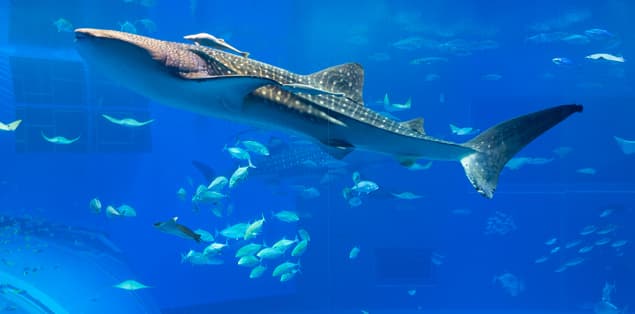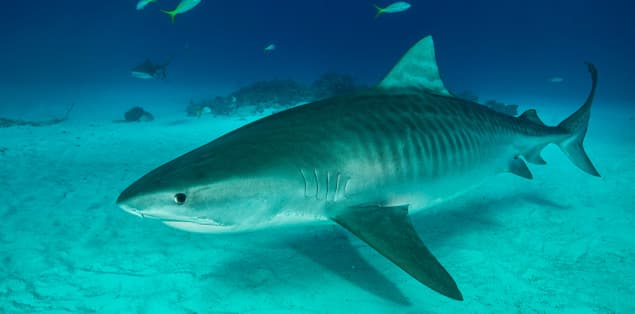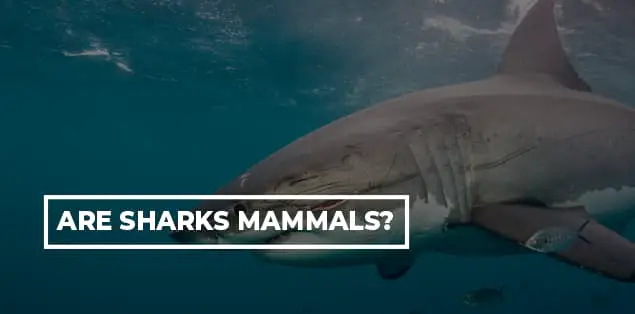So, are sharks mammals? Because sharks do not have hair, lungs, or produce milk, they do not fall under the category of mammals. Instead, they have scales, fins, and gills instead of mouths, since they are fish. Sharks, on the other hand, are classed as representatives of the class Chondrichthyes, which is distinct from mammals.
However sharks and mammals, particularly marine mammals like whales and dolphins, have certain morphological traits. Hence, these two groups of animals are not even close to being identical.
You’ll find out why we classify sharks as fish rather than mammals on this page and other fascinating information about both categories of creatures along the way.
So, without any further ado, let’s jump right into it!
Are Sharks Fish or Mammals?

We classify sharks as fish.
No, sharks do not belong to the class of animals known as mammals; rather, we consider them to be fish. There is just one category of fish containing all sharks, known as Elasmobranchii.
Many people have pondered why we classify sharks as fish. In contrast, other huge marine animals, such as dolphins and whales, are classified as mammals. However, we may use several characteristics to differentiate between creatures we have or have not classified as mammals.
Mammals are distinguished from all other animals on the earth by their ability to nurse their young.
In the case of the shark, this does not occur. When baby sharks are born, they are completely self-sufficient. They are born with a hunting instinct and do not need feeding, whether oviparous, viviparous, or ovoviviparous.
Another feature that distinguishes mammals from other animals is that they are warm-blooded and have a respiratory system and lungs. The gills of fish, including sharks, are used to breathe, and their blood is very cold.
Because of shifting climatic conditions, cold-blooded creatures are particularly vulnerable to temperature swings. On the other hand, mammals can keep a steady body temperature because of their warm blood. Finally, animals control their body temperature via the hair that protects their skin’s surface. Sharks have scales that help them swim.
Are Whale Sharks Mammals?

Whale sharks aren’t mammals; they’re the biggest fish in the world. The word “whale” is used in the name of whale sharks only because of their enormous size, not because it is a mammal. Whale sharks, like all other fish, have gills and are classified as cartilaginous fish.
Unlike mammals, whale sharks lack glandular tissue and cannot nurse their pups. Whales and dolphins have lungs, but gills allow them to take in oxygen from the sea.
Whale sharks, like hammerheads, Great White Sharks, and reef sharks, are only bigger. And while Great White Sharks are big, they are fairly small compared to whale sharks! Whale sharks, despite their enormous size, are kind and gentle creatures who like swimming with people. They serve as a food source for plankton and are generally safe for humans..
Are Great White Sharks Mammals?

No, Great White Sharks are not mammals; rather, they belong to the group or class of fish. There is just one category of fish containing all sharks, known as Elasmobranchii. We classify sharks as fish.
Are Tiger Sharks Mammals?

No, they are not.
One of the biggest species of sharks in the world is called the Tiger Shark.
You may find Tiger sharks in many tropical and temperate sections of the world’s seas. However, they are particularly prevalent in the waters around islands in the central Pacific. The sole species belongs to the genus known as “Galeocerdo.”
Even though they may live in cooler temperatures, you can often find tiger sharks in tropical or subtropical areas and are frequently present near the shore. Because of this, tiger sharks do not qualify as mammals.
Although dolphins swim in the water and resemble fish compared to other ocean creatures, we categorize them as cetaceans (marine mammals) rather than fish. Cetaceans like dolphins and whales are assumed to have evolved from the same progenitor as hippopotamuses during the Eocene Epoch.
According to fossils discovered over four decades ago in Pakistan, dolphins transitioned from terrestrial mammals to aquatic mammals due to a constantly changing world that required adaptation to life in water.
Why Are Dolphins Mammals and Not Sharks?

The dolphin is a mammal, not a fish. Because they share many characteristics with mammals, such as:
A Warm-Blooded Constitution.
Warm-blooded animals use metabolic mechanisms distinct from cold-blooded animals to keep their body temperatures above the ambient temperature. In addition, homeothermic species, such as dolphins and birds, can regulate their body temperature independent of their surroundings.
According to research, warm-bloodedness has developed in birds and mammals precisely to protect them against fungal infections. Cold-blooded species, such as amphibians and reptiles, are commonly infected with fungi.
Lungs to Breathe
If you’ve seen dolphins swim in the water, you’ve undoubtedly wondered why they keep coming up to the surface. This is because they are mammals with lungs similar to humans. When dolphins come to the surface for oxygen, they exhale to clear the water from their blowholes.
It’s not air that comes from a dolphin’s lungs that spray through its blowhole; rather, it’s a bodily fluid. This permits dolphins to breathe oxygen without having to breathe through their mouths. Furthermore, dolphins only breathe via their blowholes, not their mouths. Due to the separation of their eating and respiratory systems, dolphins can consume without water seeping into their lungs.
Dolphins also have collapsible lungs, which help them avoid decompression sickness when diving deeper than usual. Dolphins also have collapsible lungs that enable them to breathe faster than humans.
Human beings can only interchange 17% of the oxygen in their lungs with each breath, while they can exchange 80% of the total air. As a result, researchers can build solutions to lessen the hazards to people in similar conditions if they learn more about how these extraordinary lungs work under great pressure.
Ability to Give Birth
Babies are born to all animals. Reptiles, amphibians, fish, and insects all lay eggs that will hatch later. Birds are warm-blooded, yet they are neither reptiles nor mammals and belong to a distinct group.
Dolphins’ sexual maturity varies and their size determines it rather than their age.
A dolphin’s pregnancy lasts around a year. Female dolphins may potentially give birth once every two to four years, although the average time between births is three years.
Hair
When dolphin calves are born, they have hair on their rostrum, but it falls away quickly.
According to the Dolphin Research Center, the existence of dolphin body hair at birth shows that dolphins’ predecessors possessed hair to assist them control body temperature in colder conditions. Fur is the principal form of insulation for marine animals that live on land and in water. Blubber is the principal form of insulation for most marine animals, including dolphins.
Ability to Produce Lactose
Female dolphins have mammary glands that produce milk even when pregnant, allowing them to nurse older calves. At the same time, they wait for a new one to arrive. Calves usually nurse for two to four years, with some staying with their moms for up to five years.
Researchers found that the fat level of dolphin milk is equivalent to that of high-fat milk synthesized by dogs, goats, and rabbits. Unlike dogs, rabbits, and reindeer, Dolphin milk has extremely little lactose.
Dolphin calf tongues may create a “straw” around their mother’s nipple, allowing them to suck milk from her while submerged. However, we don’t consider the social activity as a defining quality of a mammal. However, dolphins’ large brains and participation in a sophisticated social network may be another justification for their classification as mammals rather than fish.
Even more astonishing is that bottlenose dolphins have evolved cognitive and social characteristics that are equivalent to or equal to those of other large-brained animals (e.g. primates).
Final Words – Are Sharks Mammals?
Sharks, as previously stated, are not mammals. A shark is a cartilaginous fish. Sharks’ skeletons are cartilage-based rather than bone-based. Although certain shark species can give birth to their young, they are not mammals since they cannot milk them. Sharks resemble fish more than mammals.
